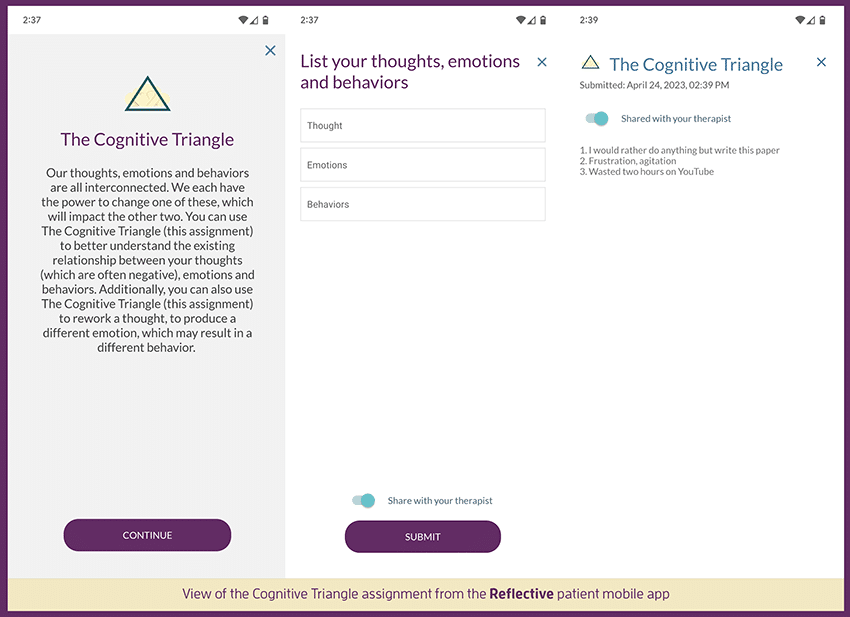What is Cognitive Behavioral Therapy (CBT)?
Cognitive Behavioral Therapy (CBT) is a widely recognized and empirically supported form of psychotherapy that focuses on examining and altering the interplay between an individual’s thoughts, emotions, and behaviors. Rooted in the premise that our cognitive processes significantly influence our wellbeing, CBT operates under the principle that by reshaping our thought patterns, we can effectively modify our emotional responses and behaviors. This therapy is structured, goal-oriented, and typically short-term, aiming to equip individuals with practical skills to address current problems and prevent future issues.
At the core of CBT is the concept that our thoughts are not mere reflections of external reality but are actively constructed interpretations. These interpretations can often be distorted or unhelpfully negative, leading to emotional distress or unproductive behaviors. CBT helps individuals identify and challenge these cognitive distortions, fostering a more balanced and realistic perspective. Through techniques like cognitive restructuring and behavioral experiments, clients learn to replace unhelpful thinking patterns with more adaptive ones, thereby influencing their emotional responses and actions in a positive manner.
Table of Contents
- What is Evidence Based Practice in mental health?
- CBT and other EBP Modalities
- Role of Homework in CBT
- Types of Homework Assignments for CBT
- When is Therapy Homework Done?
- Benefits of Using an App in Therapy
- Learn More about Reflective
What is Cognitive Behavioral Therapy in Mental Health?
At its core, CBT in mental health is about understanding and shifting the patterns of thought and behavior that contribute to a person’s distress. It’s a structured, time-limited therapy that encourages individuals to challenge and modify unhelpful beliefs, thereby improving their emotional regulation and developing personal coping strategies that target solving current problems.
CBT and other EBP Modalities
CBT is often integrated with other Evidence-Based Practice (EBP) modalities. This integration enhances its effectiveness by incorporating various techniques and strategies. For example, it can be combined with mindfulness practices to enhance awareness and acceptance, or with exposure therapy for anxiety disorders, creating a comprehensive and adaptive treatment plan.
What is the Role of Homework in CBT?
Homework assignments are a critical component of CBT, extending the therapy’s impact beyond the session. These assignments encourage clients to apply the skills learned in therapy to their daily lives, reinforcing new patterns of thinking and behavior. This practice solidifies the coping strategies and cognitive restructuring developed in therapy sessions, making them more automatic and accessible in real-world situations.

Anxiety
CBT homework for anxiety often involves exposure tasks and cognitive restructuring. These assignments encourage clients to face their fears in a controlled manner and challenge anxiety-inducing thought distortions.
Addiction
For addiction, cognitive behavioral therapy homework assignments might include journaling to track triggers and cravings, or engaging in behavioral experiments to test out new coping strategies.
Depression
In treating depression, CBT homework often focuses on activities that counteract negative thought patterns and encourage engagement in enjoyable or meaningful activities.
Eating Disorders
CBT homework for eating disorders might involve monitoring eating habits, challenging distorted beliefs about body image, and practicing healthier eating behaviors.
OCD
For Obsessive Compulsive Disorder, or OCD, exposure and response prevention tasks are common, where clients gradually face their fears without engaging in compulsive behaviors.
Trauma
CBT homework exercises in trauma-focused therapy typically include exposure therapy and cognitive restructuring to help clients process and integrate traumatic memories.
Other Uses
CBT homework can also be beneficial for many other mental health issues such as phobias, sleep disorders, and relationship challenges, providing practical tools and strategies to help patients in their daily lives.
Types of Homework Assignments for CBT
Journaling
Journaling offers a way for clients to reflect on their thoughts and feelings, providing a valuable tool for self-exploration and insight.
Exposure Tasks
Exposure tasks gradually introduce clients to feared situations or thoughts in a controlled, therapeutic manner.
Cognitive Restructuring
This involves identifying and challenging unhelpful or distorted thoughts, replacing them with more balanced and realistic ones.
Cognitive Triangle
The Cognitive Triangle is a tool that helps clients see the connections between thoughts, feelings, and behaviors, fostering awareness and change.
Behavioral Experiments
These are practical tasks that test the validity of negative beliefs and assumptions, encouraging experiential learning.
Thought Records
Thought records help clients track and evaluate the accuracy of their thoughts, particularly those that lead to distress.
Identifying Thought Distortions
This involves learning to recognize and challenge common cognitive distortions that can lead to emotional and behavioral issues.
When is Therapy Homework Done?
In Session
CBT homework is an ongoing process, typically assigned at the end of each therapy session and reviewed in the next. It’s an essential component of treatment, reinforcing the skills learned in therapy outside the session. Homework for cognitive behavioral therapy might be assigned multiple times a week and should be performed by the patient at regularly scheduled times.
How Using an App Facilitated by a Therapist Can Improve Treatment
Incorporating an app like Reflective into therapy enhances the CBT experience. It offers a convenient platform for clients to complete and track homework, access resources, and maintain continuity between sessions. It also allows therapists to monitor progress and provide timely feedback, making therapy more interactive and engaging.
Reminders
Scheduled reminders for a client using an app offers the opportunity to boost homework compliance, ensuring consistent practice.
Convenience
Mobile applications, such as for iOS or Android phones, enable patients to engage in therapeutic activities at their convenience, seamlessly incorporating the treatment process into their everyday routine and while confronted with situational triggers.
Real-Time Insights
When therapists can see their clients’ homework submissions, apps give therapists clinical insights into their client’s progress, thoughts, and feelings, enabling more tailored feedback and guidance.
Accountability
Knowing that a therapist can view their progress can motivate patients to stay consistent with their assignments.
Learn More about Using Reflective
Reflective offers a seamless way to assign CBT homework exercises and psycho-educational material. With a user-friendly mobile app, patients receive reminders and can easily access only the assignments tailored to them, enhancing their therapeutic journey.



